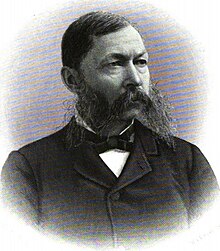Moses W. Field
Moses Wheelock Field | |
|---|---|
 From Volume 2 of 1889's The History of Detroit and Michigan | |
| Member of the U.S. House of Representatives from Michigan's 1st district | |
| In office March 4, 1873 – March 3, 1875 | |
| Preceded by | Henry Waldron |
| Succeeded by | Alpheus S. Williams |
| Personal details | |
| Born | (1828-02-10)February 10, 1828 Watertown, New York, U.S. |
| Died | March 14, 1889(1889-03-14) (aged 61) Hamtramck Michigan, U.S. |
| Resting place | Woodmere Cemetery Detroit, Michigan, U.S. |
| Political party | Republican Greenback Party |
| Spouse | Mary Kercheval Field |
| Children | Vincent Field Alice Field Mary Field |
| Parent(s) | William Field Rebecca (Wheelock) Field |
| Profession | Businessman Politician |
Moses Wheelock Field (February 10, 1828 – March 14, 1889) was a businessman and politician. He served as a member of the United States House of Representatives from the U.S. state of Michigan, and was instrumental in organizing the Independent Greenback Party.
Early life and education
Field was born in Watertown, New York, the son of William Field and Rebecca (Wheelock) Field.[1] He moved with his parents to Cato, New York, and attended public schools and graduated from the academy in Victor, New York
In 1844, he moved to Detroit, Michigan, and engaged in mercantile and agricultural pursuits. Here he married Mary Kercheval whose father, Benjamin Kercheval (1793-1855), had been an officer in the War of 1812. He built a house beyomd the then eastern limits of Detroit, at a location where it would be placed on Field Avenue (named for him) later, which his mother-in-law thought was too far from the center of town.[2] He operated the Detroit Glass Works and the Detroit Hoop Manufacturing Company. In 1865, he was instrumental in establishing the Michigan State Society for the Prevention of Cruelty to Animals, and helped create state laws relating to the humane treatment of animals.[3][4][5] He is credited with helping establish an art museum in Detroit, and helping establish public drinking fountains in Detroit in 1871.[6] Field served as Alderman of Detroit from 1863 to 1865.[7]
Career
He was elected as a Republican candidate from Michigan's 1st congressional district to the 43rd Congress, serving from March 4, 1873, to March 3, 1875.[8] He was an unsuccessful candidate for re-election in 1874 to the Forty-fourth Congress.
Field was instrumental in organizing the Independent Greenback Party, having called the national convention at Indianapolis, Indiana, on May 17, 1876.[9][10] Governor Josiah Begole appointed him a trustee of the Eastern Asylum for the Insane in 1883.[11]
In 1888, Field was elected to an eight-year term as Regent of the University of Michigan. He died on March 14, 1889, before completing the term.[12]
At the time of his death, he lived on his farm, "Linden Lawn," (where Field Avenue would later be built) in the township of Hamtramck, the still largrly rural area to the east of the city of Detroit. Most of that township would later be annexed into Detroit, including where Field lived. He is interred in Woodmere Cemetery.[13]
Personal life
On February 2, 1858, Field married Mary Kercheval. They had ten children, including Vincent Field, Alice Field and Mary Field. His family were members of the Swedenborgian Church.[14]
References
- ^ "Proposed Moses W. Field House Historic District" (PDF). City of Detroit. Archived from the original (PDF) on March 4, 2014. Retrieved March 3, 2014.
- ^ John C. Lodge. I Remember Detroit Detroit: Wayne University Press, 1949. p. 19
- ^ Michigan. Legislature. House of Representatives (1871). Journal of the House of Representatives of the State of Michigan, Volume 1. Michigan. Legislature. House of Representatives. p. 161.
- ^ Farmer, Silas (1890). History of Detroit and Michigan. Silas Farmer. p. 1224.
moses w field michigan State Society for the Prevention of Cruelty to Animals.
- ^ Farmer, Silas (1889). The history of detroit and michigan or the metropolis illustrated. S. Farmer & co. p. 72.
moses w field public drinking fountains in Detroit.
- ^ Daisy, Michael (2012). Detroit's Historic Water Works Park. Arcadia Publishing. p. 43. ISBN 9780738593630.
- ^ "Moses Whelock Field Home". detroit1701.org. Retrieved March 3, 2014.
- ^ Hinsdale, Burke Aaron (1906). History of the University of Michigan. University. p. 202.
Moses Whelock Field Watertown, New York.
- ^ Richardson, Darcy G. (2004). Others: Third Party Politics from the Nation's Founding to the Rise and Fall of the Greenback-Labor Party, Volume 1. iUniverse. p. 457. ISBN 9780595317233.
- ^ Haynes, Frederick Emory and State Historical Society of Iowa (1916). Third party movements since the Civil War, with a special reference to Iowa: a study in social politics. The State Historical Society of Iowa. p. 113.
moses w field Greenback Party].
- ^ Michigan Manual (1887). Michigan Manual. p. 268.
- ^ Hinsdale, Burke Aaron (1906). History of the University of Michigan. University. p. 202.
Moses Whelock Field Watertown, New York.
- ^ The Modern Cemetery, Volume 22. 1913. p. 189.
- ^ "Proposed Moses W. Field House Historic District" (PDF). City of Detroit. Archived from the original (PDF) on March 4, 2014. Retrieved March 3, 2014.
External links
- United States Congress. "Moses W. Field (id: F000105)". Biographical Directory of the United States Congress.
- Picture of the Moses Whelock Field Home
- Moses W. Field at Find a Grave
| U.S. House of Representatives | ||
|---|---|---|
| Preceded by | United States Representative for the 1st Congressional District of Michigan 1873– 1875 | Succeeded by |












